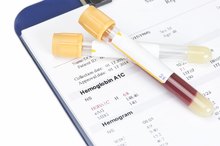Infant Blood Sugar Levels
From the moment of birth, a baby's body must take over metabolic functions previously handled by the mother's body. Blood sugar, or glucose, regulation is among the most important of these processes. Glucose serves as the primary fuel for the brain and a key nutrient for other body tissues. Infant blood sugar levels often fluctuate during the first few days of life before stabilizing. Abnormally low or high glucose levels sometimes occur in infants, which can indicate a temporary or long-term health concern.
Newborn Period
Before birth, a baby obtains glucose from the mother's circulation via the umbilical cord. After birth, a newborn's glucose supply comes exclusively from feeding and production of sugar in the baby's liver. A baby's glucose level normally drops in the first few hours of life outside the womb during this transition before gradually rebounding and stabilizing over the next 4 or so days. Newborns delivered vaginally tend to have higher blood sugar levels in the first few days of life compared to those delivered by cesarean section 3. Additionally, formula-fed infants tend to have higher blood sugars than those who are breastfed. These differences, however, are not considered medically significant.
- Before birth, a baby obtains glucose from the mother's circulation via the umbilical cord.
- Newborns delivered vaginally tend to have higher blood sugar levels in the first few days of life compared to those delivered by cesarean section 3.
Low Blood Sugar
Normal Oxygen Saturation for Infants
Learn More
Overall, potentially harmful low blood sugar (hypoglycemia) is rare among healthy, full-term newborns 4. Certain risk factors, however, increase the risk for hypoglycemia, including:
- Premature birth
- Low birth weight, also known as small for gestational age
- High birth weight, also known as large for gestational age
- Oxygen deprivation during birth or difficulty breathing after birth
- Diabetes in the mother
The American Academy of Pediatrics does not recommend blood sugar measurement for full-term, healthy infants after a normal pregnancy and delivery. Blood glucose screening is recommended, however, for newborns at risk for hypoglycemia or who exhibit signs or symptoms that might signal a low blood sugar.
High Blood Sugar
High blood sugar (hyperglycemia) rarely occurs in healthy, full-term newborns after a normal pregnancy and delivery 24. Risk factors that increase the chance for hyperglycemia in the newborn period include:
- Low birth weight
- Premature birth
- Administration of intravenous glucose and/or fats
- Health problems at or shortly after birth
Newborns with health problems are prone to high blood sugar levels because their bodies release glucose-boosting hormones in response to physical and metabolic stress. Low-birth-weight and premature infants commonly exhibit insulin resistance, meaning their bodies do not respond normally to the glucose-lowering effects of the hormone insulin. Certain medications used to treat premature babies might also boost blood sugar levels into an abnormally high range.
Uncommonly, high blood sugar in the newborn period is due to lack of insulin production, a condition called neonatal diabetes mellitus. The transient form of this condition typically develops in the first days to weeks of life and usually resolves by 18 months of age. Permanent neonatal diabetes tends to develop a bit later -- typically within the first 3 months of life -- and requires lifelong insulin replacement therapy.
- High blood sugar (hyperglycemia) rarely occurs in healthy, full-term newborns after a normal pregnancy and delivery 2.
- Uncommonly, high blood sugar in the newborn period is due to lack of insulin production, a condition called neonatal diabetes mellitus.
Normal and Abnormal Values
Newborn Period
3 Types of Jaundice
Learn More
Because blood sugar levels fluctuate in the first few days to weeks of life, an individual baby's circumstances must be considered in determining whether a value is too high or low. In general, however, abnormal glucose values in the newborn period (up to 4 weeks old) are:
- Hypoglycemia, full-term infant: less than 40 mg/dL
- Hypoglycemia, premature infant: less than 30 mg/dL
- Hyperglycemia: greater than 150 mg/dL
Older Infants
Infant blood sugar levels generally mirror those of adults by the end of the first week. Glucose levels might take a bit longer to stabilize if the baby is born prematurely or with health problems. In general, expected random glucose levels for infants after the newborn period are similar to those of adults 8:
- Hypoglycemia: less than 65 to 70 mg/dL
- Normal: 70 to 140 mg/dL
- Hyperglycemia: greater than 140 mg/dL
- Because blood sugar levels fluctuate in the first few days to weeks of life, an individual baby's circumstances must be considered in determining whether a value is too high or low.
- In general, however, abnormal glucose values in the newborn period (up to 4 weeks old) are: * Hypoglycemia, full-term infant: less than 40 mg/dL
* Hypoglycemia, premature infant: less than 30 mg/dL * Hyperglycemia: greater than 150 mg/dL Infant blood sugar levels generally mirror those of adults by the end of the first week.
Other Considerations
Healthcare providers take many factors into consideration when evaluating blood sugar levels in an infant. Talk with your doctor if you have questions or concerns about your baby's blood sugar level. Call your healthcare provider right away or seek urgent medical care if your infant develops signs or symptoms of an abnormal blood sugar level, including:
- Excessive sweating
- Weakness or floppiness
- Drowsiness or inattention
- Shakiness or jitteriness
- Breathing difficulties
- Pale and/or cool skin
- Poor feeding
- Frequent vomiting (as opposed to spitting up)
- Excessive urination
- Dry lips, mouth or tongue
- Sunken eyes
- Tearless crying
- Failure to gain weight or losing weight
Reviewed and revised by: Tina M. St. John, M.D.
- Healthcare providers take many factors into consideration when evaluating blood sugar levels in an infant.
Related Articles
References
- Breastfeeding Medicine: ABM Clinical Protocol #1: Guidelines for Blood Glucose Monitoring and Treatment of Hypoglycemia in Term and Late-Preterm Neonates, Revised 2014
- Archives of Disease in Childhood: What Is the Normal Range of Blood Glucose Concentrations in Healthy Term Newborns?
- BMC Research Notes: Is the Difference in Neonatal Blood Glucose Concentration of Caesarian and Vaginally Delivered Term Infants Requiring Separated Reference Intervals?
- Paediatrics and Child Health: Hypoglycemia in Term Newborns With a Birth Weight Below the 10th Percentile
- Archives of Disease in Childhood: Fetal and Neonatal:
- Pediatrics in Review: Neonatal Hyperglycemia
- Pediatrics: Postnatal Glucose Homeostasis in Late-Preterm and Term Infants
- Annals of Pediatric Endocrinology and Metabolism: Blood Glucose Levels Within 7 Days After Birth in Preterm Infants According to Gestational Age
- Merck Manual Professional Version: Neonatal Hyperglycemia
- Fanaroff and Martin's Neonatal-Perinatal Medicine, 10th Edition; Diseases of the; Richard J. Martin, Avroy A. Fanaroff and Michele C. Walsh
- Gardner SL, Carter BS, Enzman-Hines MI, Niermeyer S. Merenstein & Gardner's Handbook of Neonatal Intensive Care. 9th ed. St. Louis, MO: Elsevier; 2020. 435-436.
- Sharma A, Davis A, Shekhawat PS. Hypoglycemia in the preterm neonate: etiopathogenesis, diagnosis, management and long-term outcomes. Transl Pediatr. 2017;6(4):335-348. doi:10.21037/tp.2017.10.06
- Harris DL, Weston PJ, Harding JE. Incidence of neonatal hypoglycemia in babies identified as at risk. J Pediatr. 2012;161(5):787-91. doi:10.1016/j.jpeds.2012.05.022
- Stanford Children's Health. Hypoglycemia in a newborn baby.
- Sweet CB, Grayson S, Polak M. Management strategies for neonatal hypoglycemia. J Pediatr Pharmacol Ther. 2013;18(3):199-208. doi:10.5863/1551-6776-18.3.199
- MedlinePlus. Low blood sugar - newborns. Updated December 13, 2017.
Writer Bio
Amy Dixon has been writing on a local level since 2005, focusing on health and fitness. She is an ACSM Registered Clinical Exercise Physiologist and holds a Master of Science degree in exercise and wellness promotion from Slippery Rock University of Pennsylvania.









